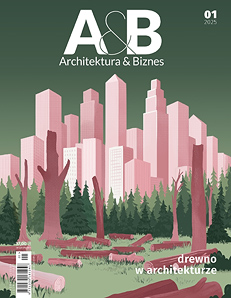After 15 years of operation, we are wondering what direction to go in the future. From our perspective, dialogue with the city does not exist at all. Yes, some changes are taking place, but they are mainly facade," says Karol Spieglanin, president of the Gdansk Agglomeration Development Forum, an organization that fights for spatial order in the Tri-City.
Ewa Karendys: - This year FRAG is celebrating its 15th anniversary. Has the city's space changed for the better during this time?
Karol Spieglanin, president of the Gdańsk Agglomeration Development Forum - a Tri-City public benefit organization focused on spatial policy issues: - There are many things that have actually improved. First of all, I see a huge change in the attitude of residents. Just 15 years ago, there was no public support for the construction of new above-ground pedestrian crossings, everyone wanted more parking spaces. And anyone who demanded something different was simply called a stoner. Over the years, the narrative in the approach to space has changed a lot.
Today we want to spend time in a nice environment, we want to walk on a level sidewalk, to live close to greenery. In some districts of Gdansk, the residents themselves demand paid parking zones, because they see that this tidies up the space, protects lawns from being torn up, makes it easier to get around.
What has gone wrong?
Worse is the level of implementation of new investments. Unfortunately, during these 15 years we have lost quite a lot of valuable development, for example in the post-shipyard areas, but also whole decaying quarters of tenement buildings in the Lower Town, of which only the facades remain. At the same time, we began to develop new space, putting the process entirely in the hands of developers.
We didn't create any new public spaces in the new districts, for example in Gdansk South, integrating residents, and we are not creating them even now in Letnica, repeating the same mistakes all the time. It seems to me that the gap between us and other cities in this regard is growing, something that residents of Gdansk may not necessarily realize yet. New development is still at a low level, still development plans are of much worse quality than in Łódź or Wrocław.
Worse?
I advise everyone to do an experiment and go to the website of the Municipal Urban Planning Bureau in Lodz, the equivalent of our Gdansk Development Office. And compare any urban development plans in the city center. In Lodz we will have a plan in which we know exactly how many stories a building has, what height it is, where the building line will be. We know what will be built. In Gdansk, there are still a lot of plans that, even if they are no longer as bad as they were those 15-20 years ago, do not specify, for example, the number of floors or the course of the building line.
As a result, we have such flowers in Gdansk, such as the investment adjacent to the "Batycki" factory, where half a floor has been dug into the ground and instead of commercial premises we have a basement and balconies at head height. In other large cities in Poland, this type of investment is not being built or are isolated cases. Two provisions, specifying the number of stories in addition to the height, and an order to enter from the level of the sidewalk, would be enough to avoid similar situations. We saved a line of ink, spoiled a piece of the city.
In Gdynia, where the city has written a requirement for competitions into local plans for the most attractive downtown locations, is it better?
Admittedly, there have not been as spectacular investments there as in Gdansk, but almost every investment in the center has improved a piece of space. There is pressure there for a higher level of investment, to adapt to modernist surroundings, meanwhile in Gdansk there is no such pressure. Although even here there are investors who come with respect for space, such as the Vastint company, which built the Riverview estate on the Motława River, or Hossa with its Garnizon project, which created a new section of Wrzeszcz.
Riverview estate
Vastint
In the first years of your activity you focused on "holes of shame." You called for the development of attractive plots of land in the center of Gdansk. However, are there places where a "hole of shame" would be better than what has been developed today?
Such an example for me is Deo Plaza on Granary Island. I think it would have been far better to wait for the development of that plot - even until now. In my opinion, we have made the space there very plastic and artificial.
Is it about the facades?
It's about the facade - the choice of materials and colors, but it's about the monofunction, because a place exclusively for tourists has been created.
But geared towards tourists is the whole Island, not just this one development.
We put up tacky, garish buildings of the Kozikowski Design project opposite Żuraw, on one of the best plots of land within the Baltic. A design chosen in a competition that could compete with projects from Amsterdam, Oslo or Copenhagen should be built here. We have been waiting 70 years for this development. Personally, I think the Granaria development on Granary Island looks best in the part designed by Studio Kwadrat.
The newest stage of Granaria - designed by Mąka Sojka Architekci studio - will also be put into use in a while.
This stage is also defending itself, especially on the Szafarnia side, although the changes made by the previous restorer did not work out well.
What school grade does the whole Granary Island deserve - overall?
I don't want to answer this question, because I will again fall into the trap of "it's not bad, because after all, it could have been worse." This is the phrase we often hear in Gdansk.
"Before the new development on Granary Island there were scrubs ..."
... "And in front of the Forum Gdansk, Gilida was scary." There are both good and bad buildings on Granary Island. If I had a choice to have the Island look as it did 15 years ago and now be developed anew, with designs chosen in competitions, I would prefer to wait for a more worthwhile development. Because in fact this project will be with us for decades, if not centuries.
Granary Island - which, after all, was built as part of a public-private partnership with the city - lacks a social function - such as a library or community center. It was inconceivable that even some public housing would be built there. But on the other hand, why not?
Well, precisely, why not? At least we would have permanent residents there. And if not public housing, then some function that would serve the residents: a business incubator, a media library. At the moment we have very expensive rental apartments and restaurants that are not an offer for local residents, because they are typically geared towards tourists.
Deo Plaza on Granary Island
Ewa Karendys
Fifteen years ago, there were also no new investments in the Young City area. Instead, there were great expectations of what would be built.
Again, one can say "it's not bad". I am very hopeful about the Kaiser Shipyard plans, which give hope for the highest level in the city. But on the other hand, we have been striving for years to prepare the Gdansk City Street Standard. Meanwhile, in the Cranes YIT development, a building is being constructed that has a blank wall of garages on the side of Nowa Walowa (Fr. Popieluszko) Street. There is also no sidewalk with which to reach NOMUS. And at this point I wonder why all these discussions about the Young City space and the hours spent developing standards?
15 years ago we also said that the plans for the Young City needed to be changed. But here nothing has changed.
The local plans have not been changed and will not be changed again. Again, we put the entire development process in the hands of developers.
Instead, Gdansk succeeded with the landscape resolution.
In terms of space, this is one of the most important changes that have taken place in the city over the past decade. We owe the landscape resolution largely to Paweł Adamowicz, who persistently pushed for its introduction. Thanks to this, today we are a model for other cities in terms of cleaning up advertising chaos.
The approach to the aesthetics of the city has also changed. One of our first demands was to establish a department dealing with aesthetics in the City Hall. This was successful, and an aesthetics desk was created, later taken over by the Gdansk Roads and Greenery Board. Thus, as an association, we indirectly contributed to the fact that, for example, Stągiewna Street was turned into a promenade after renovation, its aesthetic standards changed for the better.
We also managed to renovate many facades in the Main City at a low cost under the Façades OdNowa program .
However, the program was halted by the previous preservationist.
We hope to return to this project. Also successful was the courtyard closure program for quarters in the Main City, which we also pushed for, explaining that the space between the main streets must look better.
We are pleased that the creation of cubicle parking lots in Gdansk has been halted. The ones on Podwale Staromiejskie were the nail in the coffin of downtown's parking policy. I hope that someday cubic parking lots will be built, but that they will be done with a head and in completely different locations.
We have succeeded in changing the approach to air quality. Several years ago, together with LPP and the School of Banking, we built a community network of air quality sensors. And initially we were criticized by the city authorities that we didn't need such a thing, because, after all, the air is great here. Meanwhile, today we are replacing stoves, there are special units in the Municipal Police that control what residents burn.
Recently, however, it can be noticed that you are less active, you speak less often on space issues. Why?
Due to the pandemic and limited resources for NGOs,over the past few years we have focused on activities that are less visible in public spaces and more on working with universities. For example, we are still continuing the air quality monitoring project, funded through LPP. We are in the process of installing the first sensors that will monitor the interiors of LPP office buildings. The results of these measurements will be material for establishing guidelines for air quality standards for public buildings at the European Union level. We are implementing the project in scientific cooperation with, among others, the School of Banking and the Aristotle Technical University of Thessaloniki. We also actively cooperate with the Architecture of Cultural Spaces at the Academy of Fine Arts and students from Poland, Slovakia or Croatia.
After 15 years of activity, we ourselves are wondering in what direction to go in the future. Whether in a more science-think-tank form, or, however, taking the floor, as before, in the public debate. In recent years, the aforementioned pandemic, political polarization, or the war in the east, have caused spatial topics to recede into the background. Some of that is behind us now. Many people point out to us that the public discussion of public space lacks a critical view of the actions implemented by the city authorities in Gdansk. Unfortunately, the city's attitude in response to substantive criticism is quite "Teflon-like."
What does this mean?
Unfortunately, City Hall's approach to criticism is different today than it was under Mayor Pawel Adamowicz. From our perspective, dialogue with the city does not exist at all. I have the impression that the authorities are convinced of their greatness, because they have no one to lose to, PiS has little support in the capital of the Pomeranian Voivodeship. In general, City Hall does what it feels like doing itself, the opinion of residents does not matter.
On the left, Długie Pobrzeże in Gdansk, on the right: the Deo Plaza investment
Ewa Karendys
An important decision regarding space was the appointment of the position of City Architect....
Yes, some changes are taking place, but they are mainly facade. An example is the City Street Standard - apparently there is one, but so what if the provisions of this document are not applied?
We sought the position of the City Architect, meeting with Vice Mayor Piotr Grzelak and Alan Aleksandrowicz on this issue. However, it was created in a completely different form than we advocated. With less authority.
The position of the city architect is too weak?
The position should have a stronger position in the hierarchy of the office. I realize that Prof. Piotr Lorens has his hands full, he managed to stop several nightmares - such as the awful 100-meter towers in Letnica. But let's not kid ourselves, the great, systemic, improvement in the quality of investments in the city is not there. Gdańsk authorities have repeatedly sent signals that there is no will to change anything revolutionary.
At the end of September, Gdansk appointed a position of urban planner. However, there is no expectation of a change in spatial policy, as this function was linked to the position of BRG director.
On the one hand, in order to satisfy organizations like ours, it is decided to implement some kind of walkway, plant trees, implement a bike path. On the other hand, Gdansk winks at motorists, boasting of rankings according to which it is among the most driver-friendly cities. The city stands apart, and there is no will to change this. Virtually on every level. It is administered, but not managed. And in this way we simply won't go far. We are trotting in place, while others are moving forward with nimble steps.























